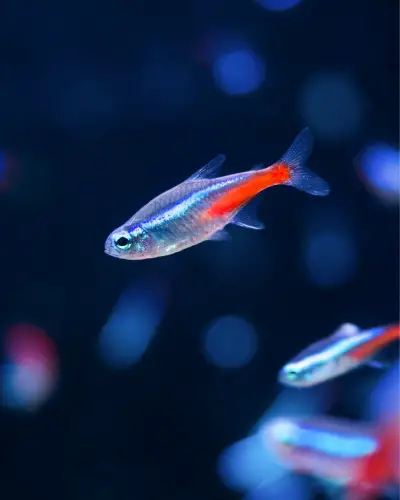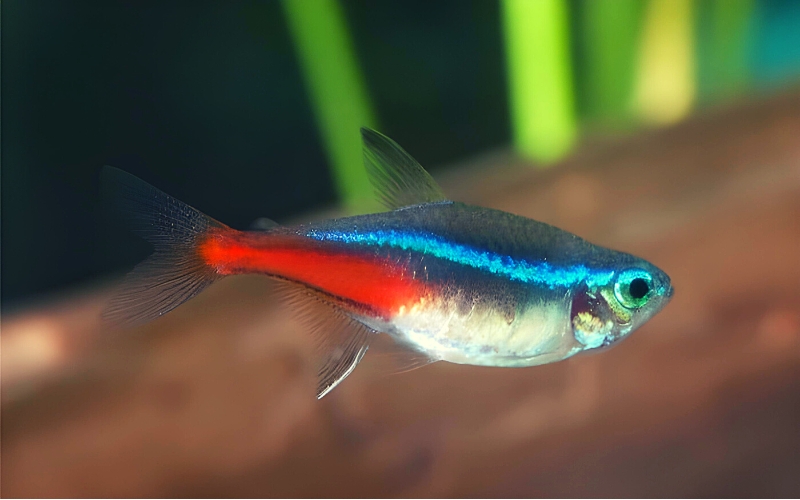Neon tetras are among the most popular aquarium fish due to their vibrant colors and peaceful nature. These small schooling fish are perfect for community aquariums, but many aquarists wonder just how big do neon tetras get in a tank.
Understanding tetra care needs, growth, and tank requirements is essential for anyone considering adding these beautiful fish to their aquarium.
Neon tetras typically grow to a maximum size of around 1.5 inches in length when kept in a tank. This size makes them an excellent choice for small to medium aquariums, as their petite stature allows them to swim gracefully in groups without needing an expansive space.

Providing them with optimal water conditions, a balanced diet, and a stress-free environment ensures they reach their full potential while maintaining their vibrant appearance.
Table of Contents
ToggleHow Big Do Neon Tetras Get in a Tank?
Neon tetras typically grow to a size of about 1.5 inches to 2 inches in length when kept in a well-maintained tank. Their small size makes them an ideal choice for aquarists looking to create a vibrant community aquarium.
The growth of neon tetras can be influenced by various factors, including water quality, diet, and tank conditions. When properly cared for, these fish can reach their full size within several months, showcasing their stunning colors and active swimming behavior.

In addition to their length, the overall health of your tetras plays a significant role in their growth. Frequent water changes and maintaining appropriate water parameters contribute to their development. A stable environment allows these fish to thrive and reach their maximum size comfortably.
As a result, it’s crucial for aquarists to monitor their tanks regularly and adjust conditions as needed to ensure their tetras grow to their full potential.
Neon Tetra: Fish Species Profile
The neon fish tetra (Paracheirodon innesi) is a small freshwater fish native to the Amazon Basin. They are well-known for their striking blue and red coloration, which can make any aquarium look vibrant and inviting.
This species is peaceful and enjoys the company of its own kind, thriving in schools of at least six individuals. Their friendly nature makes them a perfect addition to community fish tanks, where they coexist harmoniously with other small fish and aquatic creatures like shrimp.
Neon tetras are also relatively low-maintenance, making them an excellent choice for beginners. They prefer a dimly lit environment with plenty of plants and hiding spots, which helps to mimic their natural habitat.
It’s essential to provide them with a suitable substrate and soft, acidic water to maintain their health. Understanding the specific needs of tetras will ensure that they remain healthy and colorful in your aquarium, delighting both you and your guests.
How Many Neon Tetras Should Be Kept Together?
When keeping neon tetras, it is highly recommended to keep them in schools of at least six or more. These schooling fish feel more comfortable and secure when they are in a group, which helps to reduce stress and promote natural behaviors.
In smaller groups, neon tetras may become shy and less active, which can negatively impact their overall health and wellbeing. By maintaining a proper school size, aquarists can enjoy observing their lively interactions and playful swimming patterns.
Additionally, keeping neon fish in larger groups can lead to more vibrant colors, as they often display their best hues when surrounded by their school.
A well-balanced group of male and female neon tetras can also promote breeding behaviors, adding excitement to your aquarium. Ultimately, ensuring that neon tetras are kept in sufficient numbers is crucial for their happiness and health, making it a fundamental aspect of their care.
How Long Does It Take for Neon Tetras to Reach Full Size?
Neon tetras typically take about six months to reach their full size of 1.5 to 2 inches in length. During this time, they require proper nutrition and stable water conditions to grow healthily.
A balanced diet consisting of high-quality flakes or pellets, along with occasional live or frozen foods, will support their growth and development. Regular feeding and attention to their dietary needs can significantly impact their overall size and coloration.
In addition to a proper diet, water quality is crucial in ensuring that neon tetras grow adequately. Frequent water changes should be conducted to maintain optimal levels of ammonia and other pollutants. Keeping the tank clean and well-filtered will create a suitable environment for these fish to thrive.
By understanding the requirements for growth, aquarists can help their neon tetras reach full size while keeping them happy and healthy.
Do Neon Tetras Need a Lot of Space?
Neon tetras do not require an excessively large tank, but providing adequate space is essential for their well-being. A tank size of at least 10 gallons is recommended for a school of six neon tetras, allowing them enough room to swim and explore.
In larger tanks, neon tetras can exhibit more natural behaviors, which contributes to their overall health and happiness. A well-planned aquarium setup with plants and hiding spots will help create a comfortable environment for these small fish.
Moreover, the tank should be equipped with a reliable filter to maintain water quality, as neon tetras are sensitive to poor conditions.
While they do not need a lot of space compared to larger fish species, ensuring that they have a suitable environment is vital. A well-maintained tank with the right dimensions will allow tetras to thrive and display their beautiful colors, making them a joy to keep in any aquarium.
What Size Tank for 10 Neon Tetras: best tank size for your pet fish
For a school of 10 neon tetras, a tank size of at least 15 to 20 gallons is recommended. This size provides ample space for the fish to swim and interact without overcrowding, which can lead to stress and health issues.
A larger tank also helps maintain stable water parameters, reducing the frequency of water changes needed to keep the environment healthy. It’s crucial to consider the number of fish in relation to the tank size to ensure a balanced ecosystem.
When choosing the right tank, aquarists should also consider the layout, including plants and decorations. Providing ample hiding spots and open swimming areas will create a more natural environment for the neon tetras.
Furthermore, a tank with a lid is essential to prevent any jumping, as these active fish may attempt to escape. By investing in an appropriately sized tank and creating a suitable habitat, you will ensure that your neon tetras live a happy and healthy life in your aquarium.
Commonly Asked Questions about How Big Can Neon Tetras Get (FAQs)
How big do neon tetras grow in a tank?
Neon tetras typically grow to about 1.5 inches long when fully matured. In a well-maintained tank, you can expect them to reach this size as adults.
What care do neon tetras need to thrive in a tank?
To care for neon tetras, make sure to keep them in schools of at least six individuals. They appreciate a well-planted tank with a gentle water flow and stable water parameters.
Is it necessary to keep neon tetras in schools?
Yes, you should keep neon tetras in schools of at least six to ensure their well-being. This social behavior is crucial for their mental health and to reduce stress.
What should I feed my neon tetras?
You can feed your tetras a varied diet including high-quality flake foods, micro-pellets, and occasional live or frozen foods such as daphnia or brine shrimp.
Can I keep neon tetras with other fish?
Yes, neons tetra fish can coexist with many other small, peaceful fish. However, make sure to avoid larger, aggressive species that might bully them.
How often should I change the water in a neon tetra tank?
It’s recommended to change about 10-15% of the water weekly to maintain good water quality and ensure a healthy environment for your neon tetras.
What is the ideal tank size for neon tetras?
A tank size of at least 10 gallons is ideal for a school of neon tetras. This provides enough space for them to swim and reduces stress levels.
Are there any special considerations when buying neon tetras?
When buying neon tetras, make sure to choose healthy fish from a reputable store. Look for vibrant colors and active swimming behavior to ensure they are in good health.
How long do neon tetras live in captivity?
Neon tetras typically live for about 5-10 years in captivity, provided they are given proper care and a suitable environment.
What are the signs of stress in neon tetras?
Signs of stress in neon tetras include hiding, faded colors, erratic swimming, or changes in appetite. If you notice these behaviors, it may be time to assess their tank conditions.
Are cardinal and neon tetras the same?
No, Neon and cardinal tetras are different species of fish, though closely related. Cardinals have a red stripe extending the full body length, while Neons’ red stripe is shorter.
Do tetras like fast flowing water?
No, most tetras prefer slow-moving water similar to clearwater streams, not fast-flowing water.
Conclusion
In summary, understanding how big do neon fish get and what they need for optimal growth is vital for any aquarist. These small, colorful fish thrive in schools and require suitable tank sizes to ensure their well-being. By providing proper care, maintaining clean water, and feeding them a balanced diet, you can enjoy the beauty and activity of neon tetras in your aquarium. Remember to keep them in groups of at least six, and choose an appropriate tank size to create a thriving community for these delightful pet fish.
You may like these Articles
- Cardinal Tetra Fish 101: Cardinal Tetra Comprehensive Guide!
- Neon Tetra Care Guide for Beginners (Experts Advice)
- Identifying Neon Tetra Disease: 5 HIDDEN Signs You MUST Know
- Neon Tetra Life Expectancy: Avoid These 3 Deadly Mistakes!
- Identifying Pregnant Neon Tetra Fish: (3 Proven Symptoms)
- How Long Do Neon Tetras Live: (Unlock Their Hidden Lifespan)
- What to Feed Neon Tetras: 7 Best Foods for (Vibrant Colors!)
- How Many Neon Tetra in 10 Gallon: (Best Practices)
- The Ideal Neon Tetras Tank Size: A Comprehensive Guide
- Neon Tetras Vs Cardinal Tetras: (Which Species Right for You!)
- Cardinal Tetra Vs Green Neon Tetra 101: (Discover the Winner!)
- Are Neon Tetra Hardy: 7 Secrets to Tank-Raising Bliss!
- How Many Neon Tetras Per Gallon of Water: (The Magic Number)
- Do Neon Tetras Need a Water Heater in Tank: (Ultimate Care Sheet)




